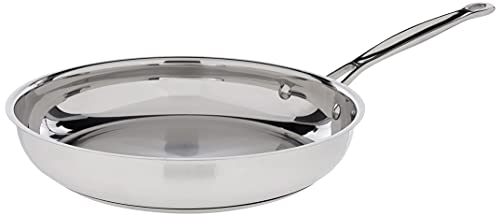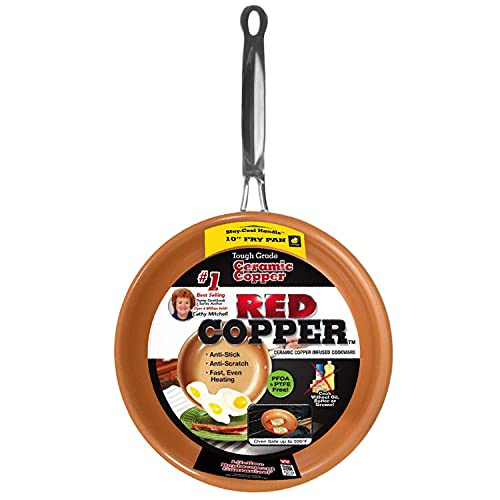If you’re a fan of cooking steaks like many of us are, then you know that the cookware you use is just as important as the steak itself. Choosing the right skillet can make the difference between a perfectly cooked steak and one that’s undercooked or overcooked. Cast iron, stainless steel, and copper are three popular materials for steak cookware, each with their own unique advantages. Keep reading to learn more about why these three materials are each great options for cooking your perfect steak.
Table of Contents
Cast iron: The Classic Choice For Steak
When it comes to cooking steak, there are few things as important as choosing the right cookware. The best pan to cook steak is one that can get hot quickly and stay hot, allowing you to sear the meat and lock in flavor. Among the many options out there, cast iron stands out as a classic choice for steak lovers.
Cast iron pans have been around for centuries, and for good reason. These heavy-duty pans heat up evenly and retain heat well, making them perfect for cooking steak to perfection. The thick material also helps to create a beautiful crust on the surface of the steak, giving it a delicious seared flavor that is hard to achieve with other pans.
| Advantages of Cast Iron Pans for Cooking Steak | Disadvantages of Cast Iron Pans for Cooking Steak |
|---|---|
| -Retains heat well – Distributes heat evenly – Creates a delicious crust on steak – Can be used on the stovetop or in the oven | – Can be heavy and difficult to handle – Needs to be seasoned regularly to prevent rusting – May not be the best choice for delicate or lean cuts of steak |
When using a cast iron pan for cooking steak, it’s important to preheat the pan before adding the steak. This will ensure that the meat sears properly and doesn’t become too tough. You should also avoid using too much oil or butter, as this can cause the steak to become greasy instead of crispy.
If you’re looking for a reliable and classic option for cooking steak, a cast iron pan is definitely worth considering. While it may have some downsides, such as being heavy and requiring regular maintenance, a well-seasoned cast iron pan can last a lifetime and provide delicious results every time.
Stainless Steel: Durability And Versatility
When it comes to cooking steak, choosing the right pan is crucial to achieve the desired flavors and texture. While cast iron is considered a classic choice for steak cooking, stainless steel pans are equally versatile and durable.
One of the best advantages of using a stainless steel pan is its durability. Unlike other materials like non-stick pans that can easily be scratched or damaged, stainless steel pans can withstand high heat and constant use without losing its quality. You can use metal utensils and even transfer it from the stove to the oven without worrying about damaging the pan.
| Pros | Cons |
|---|---|
| – Durable – Easy to clean – Non-reactive – Good heat distribution – Allows for proper searing | – Food might stick if not heated properly – Not ideal for delicate foods – Not good at retaining heat |
In terms of versatility, stainless steel pans can be used in a variety of ways such as sauteing, braising, and frying, making it a great investment for your kitchen. It has a non-reactive surface that allows you to cook acidic foods without altering their flavors. Stainless steel also has good heat distribution, allowing your steak to cook evenly and retain its moisture.
Using a stainless steel pan to cook steak requires a bit of technique. Make sure to preheat the pan before cooking and add oil only when the pan is already hot. This will prevent the steak from sticking and allow proper searing. Also, do not overcrowd the pan as this will lower the temperature, causing uneven cooking.
In conclusion, while cast iron pans may be the traditional choice for cooking steak, stainless steel pans offer durability and versatility that is worth considering. It allows for proper searing and even cooking, making it a great investment for steak lovers who are looking for a reliable and long-lasting pan to use.
Copper: Heat Control And Quick Cooking Times
Copper is a fantastic material for cookware due to its excellent heat conductivity and quick cooking times. If you’re a fan of perfectly cooked steaks, then copper is definitely worth considering as it can help ensure your meal is cooked to perfection. When looking for the best pan to cook steak, you might want to consider investing in a copper pan, and here’s why:
- Firstly, copper pans heat up quickly and distribute heat evenly. This is essential when cooking steak as you want the heat to be evenly distributed, ensuring that your steak cooks at the same rate. Copper pans are also known to cool down quickly once they are removed from the heat source, preventing the steak from dry-cooking and overcooking.
- Heat Control: The copper cookware allows for quick temperature adjustments, allowing you to have better control over how your steak is cooked. You can turn down the heat as needed to prevent overcooking or raise it to get that perfect sear.
- Quick Cooking Times: Copper pans heat up quickly and cool down fast, allowing for a faster cooking time. This means you can get a perfectly cooked steak in a shorter amount of time.
In conclusion, copper is an excellent choice for the best pan to cook steak. You’ll love the heat control and quick cooking times, ensuring that your steak is cooked to perfection every time. So, invest in a copper pan today and elevate your cooking experience!
Best Pan To Cook Steak FAQs
Cast iron is an excellent choice for steak because it provides even heat distribution and retains heat well. This means that your steak will cook evenly and stay hot while you eat it.
Yes, stainless steel is a durable and versatile material that is great for cooking steak. It heats up quickly and evenly, and it’s easy to clean.
Copper is an ideal choice for steak because it allows for precise heat control and quick cooking times. Its superior heat conductivity ensures that your steak will cook evenly throughout.
To season a cast iron skillet, preheat your oven to 350°F. Rub a thin layer of oil onto the skillet with a paper towel, making sure to cover the entire surface. Bake the skillet for an hour and let it cool in the oven. Repeat this process several times to build up a non-stick coating.
Yes, stainless steel is a durable material that can withstand metal utensils. However, it’s important to avoid using abrasive cleaners or scouring pads that can scratch the surface.
To clean copper cookware, use a mixture of vinegar and salt or a specialized cleaner made for copper. Avoid using abrasive cleaners or scouring pads, as they can scratch the surface.
To maintain your cast iron skillet, avoid using soap and water to clean it, as this can strip the seasoning. Instead, wipe it clean with a paper towel or sponge, and apply a thin layer of oil after each use to prevent rusting.

Hi, I’m Jen from New Mexico. I have been working from home as a graphic designer for a long time. While working at home, I realized that I enjoy spending time in the kitchen. The kitchen is my biggest hobby. I set up this site to relay the products and experiences I’ve tried. I review many kitchen equipment and share them with you!












